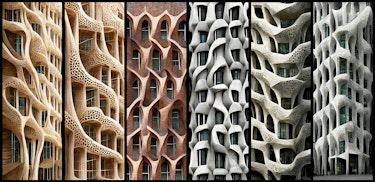In recent years, the integration of Artificial Intelligence (AI) into various industries has revolutionized the way we work and interact with technology. Architecture, as a field, has also embraced the potential of AI to enhance design, planning, and construction processes. By leveraging AI-powered tools and algorithms, architects can optimize their workflows, generate innovative designs, and improve the efficiency of their projects. This essay explores six key practices that are bringing AI into architecture, transforming the way architects approach their work.
.jpg?ixlib=gatsbyFP&auto=compress%2Cformat&fit=max&q=75&w=375)
CUUB studio
1. Generative Design
Generative Design is a powerful application of AI in architecture that enables architects to explore and generate a wide range of design options. Traditionally, architects would spend countless hours manually sketching and iterating designs. However, with AI, architects can now define a set of constraints and objectives, and AI algorithms can produce countless design alternatives based on these inputs. This process not only saves time but also fosters creativity and innovation by generating unconventional design solutions that may not have been considered otherwise. Architects can evaluate these generated designs and select the most promising options, ultimately leading to optimized and efficient structures.
AI-powered generative design algorithms can also take into account factors such as building codes, site conditions, and user preferences. By considering these variables, architects can create designs that are not only visually appealing but also functional and compliant with regulations. Generative Design opens up new possibilities for architects to explore unique and efficient design solutions.

Credit: ParametricArchitecture
2. Automated Design Optimization
AI can also be used to optimize the design of architectural elements. Traditionally, architects would rely on their expertise and intuition to make design decisions. However, AI algorithms can analyze vast amounts of data and generate optimized designs based on specific criteria, such as energy efficiency, structural stability.
For example, in the design of building facades, AI algorithms can analyze factors such as solar exposure, shading, and material properties to generate designs that maximize energy efficiency and occupant comfort. Similarly, in structural design, AI algorithms can optimize beam and column layouts, minimizing material usage while ensuring structural integrity. By automating the design optimization process, architects can create more sustainable and functional buildings while reducing construction and operational costs.

Credit: The Architect’s Newspaper
3. Building Performance Analysis
With the integration of AI, architects can conduct comprehensive building performance analysis at an unprecedented level of detail. AI algorithms can simulate various scenarios, such as energy consumption, lighting analysis, airflow simulations, and thermal comfort, to assess the performance of a building design. This analysis helps architects understand how different design choices impact the building's performance and make informed decisions regarding energy efficiency, sustainability, and occupant comfort.
By analyzing this data, architects can identify areas for improvement and optimize building systems accordingly. For example, AI-powered analysis can reveal areas of excessive energy consumption, allowing architects to implement energy-saving strategies such as improved insulation or efficient HVAC systems. Additionally, AI algorithms can assist in daylighting analysis, optimizing the placement of windows and skylights to maximize natural light and reduce energy usage. By harnessing AI for building performance analysis, architects can design structures that are more environmentally friendly and promote human well-being.

Credit: The Architect’s Newspaper
4. Construction Automation
AI technologies are also being deployed to automate various aspects of the construction process. Robotic systems and AI-driven machinery can assist in tasks such as bricklaying, concrete pouring, and material transportation. By automating these labor-intensive processes, architects can enhance productivity, minimize errors, and reduce construction time and costs.
Furthermore, AI algorithms can monitor construction sites for safety compliance, detecting potential hazards or risks and notifying project managers in real-time. This proactive approach to safety management can significantly improve site safety and reduce accidents. By leveraging AI for construction automation, architects can streamline the construction process, ensure high-quality construction, and create safer working environments.

Credit: Floornature
5. Intelligent Material Selection
Selecting the right materials for a building project is crucial for its overall performance and sustainability. With the help of AI algorithms, architects can identify optimal material choices based on specific project requirements, considering factors such as cost, durability, environmental impact, and aesthetic preferences.
AI-powered material selection tools can analyze vast material databases and provide architects with data-driven recommendations. For instance, if sustainability is a priority, AI algorithms can suggest environmentally friendly materials with low embodied energy and high recyclability. Additionally, AI can assess the lifecycle performance of materials, considering factors such as maintenance requirements and longevity. By making informed decisions regarding material selection, architects can create designs that are not only aesthetically pleasing but also efficient, sustainable, and cost-effective.

Credit: DesignWanted
6. Smart Building Management
Once a building is completed, AI continues to play a significant role in its operation and management. AI-powered building management systems can collect data from sensors installed throughout the building, monitor energy consumption, optimize HVAC systems, and detect anomalies or inefficiencies. This real-time data analysis enables architects to gain insights into the building's performance over time and identify areas for improvement.
By analyzing the collected data, architects can implement strategies to enhance energy efficiency, occupant comfort, and maintenance operations. For example, AI algorithms can automatically adjust HVAC settings based on occupancy patterns and weather conditions, optimizing energy usage while maintaining comfortable indoor environments. AI can also assist in predictive maintenance by analyzing sensor data to detect equipment malfunctions or performance degradation before they become critical issues. By leveraging AI for smart building management, architects can ensure that their designs continue to perform optimally throughout their lifespan.

Credit: Dezeen
The integration of AI into architecture has brought about a paradigm shift in the way architects approach design, planning, and construction processes. From generative design and automated optimization to building performance analysis and construction automation, AI technologies are enhancing efficiency, sustainability, and functionality in the field of architecture. Moreover, intelligent material selection and smart building management contribute to the long-term performance and maintenance of structures.
As AI continues to evolve, architects will have even greater opportunities to leverage its capabilities and drive innovation within the industry. With ongoing advancements in AI algorithms, data analysis, and automation technologies, architects can harness the power of AI to create more sustainable, intelligent, and user-centric built environments. By embracing AI practices, architects can shape a future where architecture seamlessly integrates with technology, resulting in buildings that are not only aesthetically pleasing but also efficient, sustainable, and responsive to the needs of occupants and the environment.
